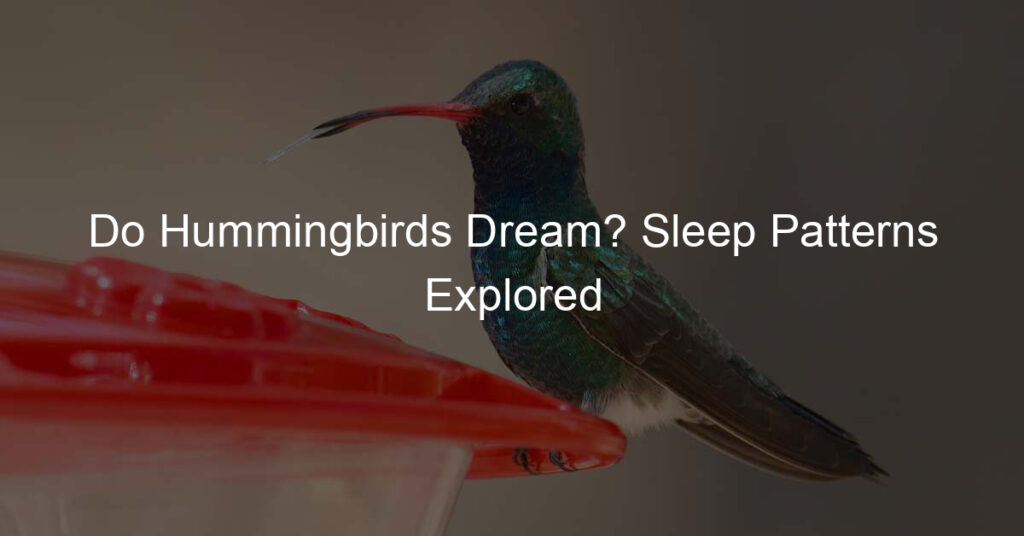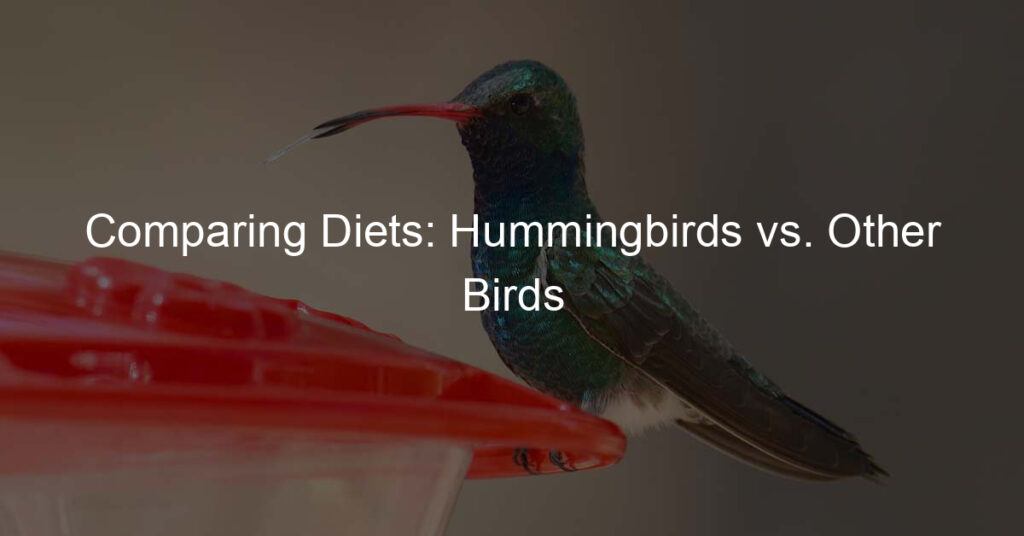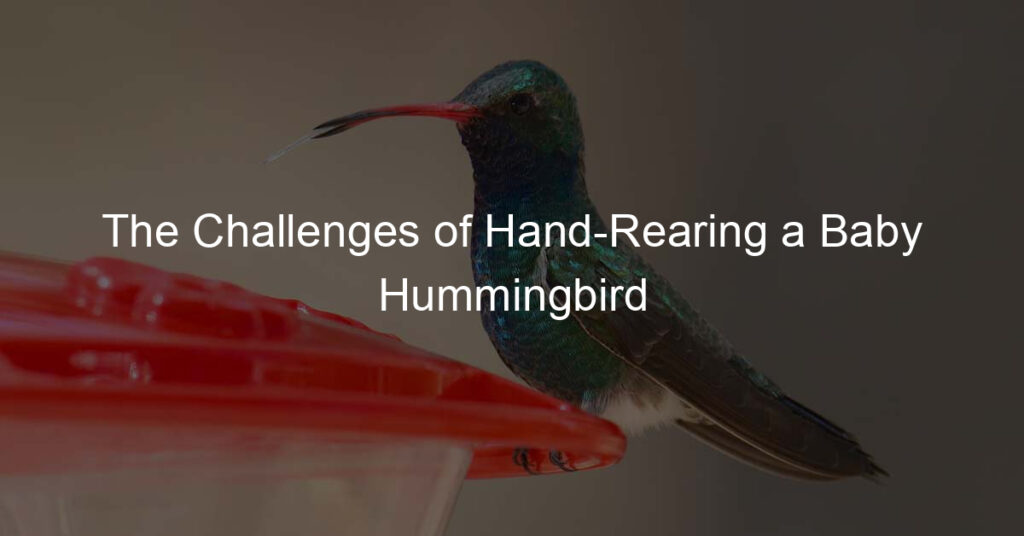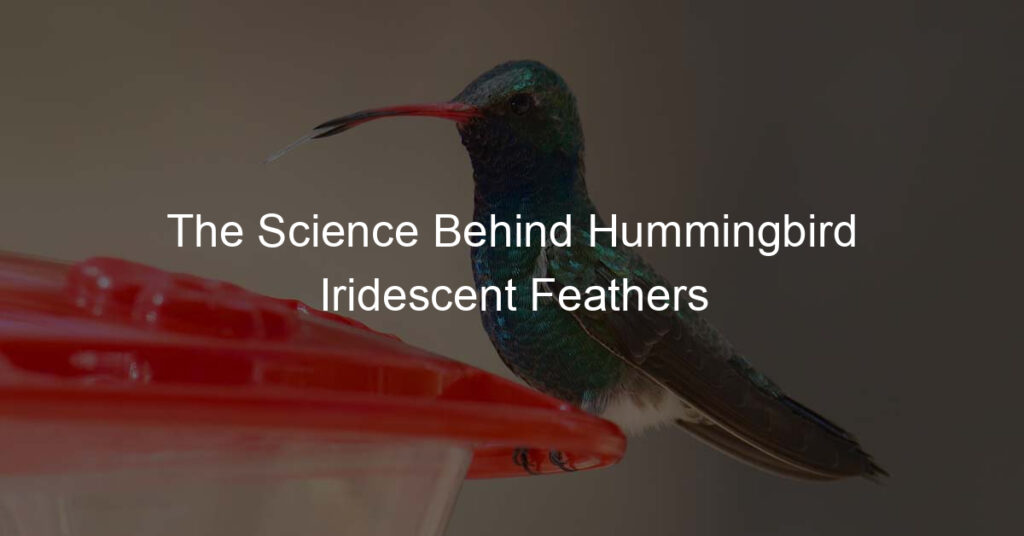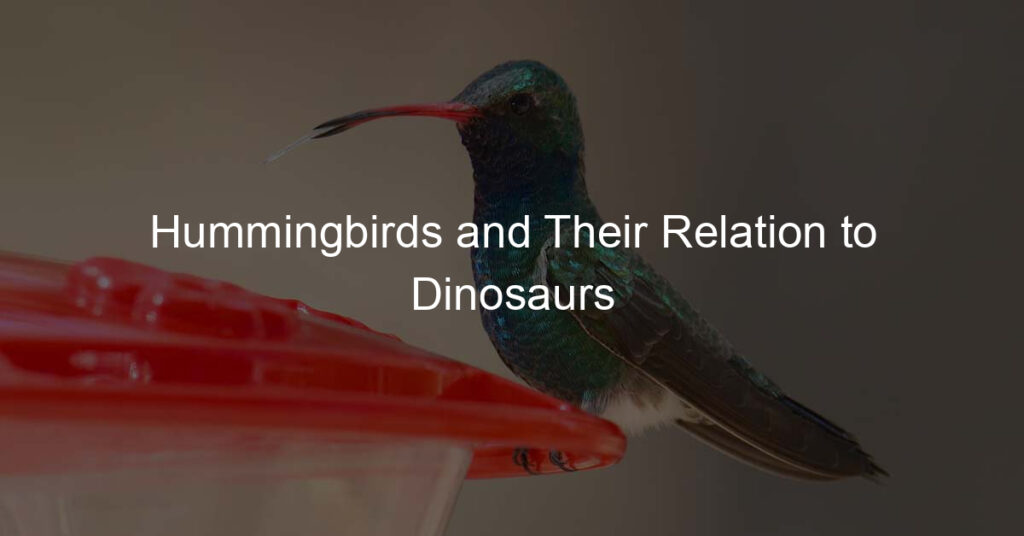In this informative blog post, we delve into the fascinating world of hummingbirds as we explore their sleep patterns and ask the intriguing question – do hummingbirds dream? We investigate their unique sleep habits, the concept of torpor, and what current research suggests about the possibility of hummingbirds having dreams.
Understanding Hummingbirds: A Brief Introduction
Hummingbirds are fascinating creatures that captivate the imagination with their vibrant colors, incredible agility, and unique behaviors. These tiny birds belong to the Trochilidae family and are known for their ability to hover in mid-air and fly backwards. With over 300 species, hummingbirds can be found across the Americas, from Alaska to Argentina. They are known for their rapid wingbeats, which can reach an astonishing 80 beats per second.
One of the most intriguing aspects of hummingbirds is their sleep patterns. Unlike most birds, hummingbirds have a peculiar way of sleeping that sets them apart. They do not sleep like other birds, such as perching on a branch with their heads tucked under their wings. Instead, hummingbirds enter a state of deep sleep called torpor, which is crucial for their survival.
During torpor, a hummingbird's metabolic rate drops significantly, and its body temperature decreases to conserve energy. This allows them to enter a state of suspended animation, where their heart rate and breathing slow down dramatically. In fact, their heart rate can drop from around 500 beats per minute to as low as 50 beats per minute during torpor. This unique adaptation helps hummingbirds conserve energy during periods of low food availability or harsh weather conditions.
Hummingbirds typically enter torpor at night to conserve energy when food sources are scarce. However, they also enter torpor during the day, especially during hot weather, to avoid overheating. This ability to regulate their body temperature is essential for their survival, as hummingbirds have high metabolic rates and need to consume large amounts of nectar to fuel their energy-demanding flight.
The Unusual Sleeping Habits of Hummingbirds
Hummingbirds have a reputation for their unusual sleeping habits that differ greatly from other birds. Unlike most birds that sleep for long periods at a time, hummingbirds have short sleep cycles and frequent awakenings. They typically sleep for only a few seconds or minutes at a time, compared to several hours of continuous sleep in other bird species.
This unique sleep pattern is a result of their high metabolic rate and energy demands. Hummingbirds need to constantly refuel their bodies to sustain their rapid wingbeats and hovering abilities. Their short sleep cycles allow them to quickly awaken, search for food, and refuel before returning to sleep. This behavior ensures that they have a constant supply of energy to fuel their active lifestyles.
Additionally, hummingbirds have the ability to sleep while perched or even while hovering in mid-air. This remarkable feat is made possible by their unique muscle structure and wing positioning. Their muscles are designed to lock their wings in place, allowing them to maintain a stationary position without exerting much energy. This allows them to rest and sleep without falling or losing their balance.
Another interesting aspect of hummingbird sleep is their ability to enter torpor on demand. Unlike other animals that have specific sleep schedules, hummingbirds can adjust their sleep patterns based on environmental conditions and food availability. If resources are scarce, they can enter torpor for extended periods to conserve energy. Conversely, when food is abundant, they can reduce their torpor duration and sleep less frequently. This flexibility in their sleep patterns allows them to adapt to changing circumstances and survive in diverse habitats.
What is Torpor?
Torpor is a fascinating physiological state that hummingbirds enter during periods of rest or in response to environmental conditions. This temporary state is characterized by a significant decrease in metabolic rate, heart rate, and body temperature. It is an energy-saving mechanism that allows hummingbirds to conserve their limited energy reserves and survive during times of scarcity.
- 1. The Mechanics of Torpor:
During torpor, hummingbirds lower their metabolic rate by as much as 95%, which significantly reduces their energy expenditure. This means that their bodies require minimal amounts of food and oxygen to sustain basic bodily functions. Their heart rate can drop from around 1,200 beats per minute to as low as 50 beats per minute, and their body temperature can decrease from an average of 104 degrees Fahrenheit to as low as 48 degrees Fahrenheit. - 2. Triggering Torpor:
Hummingbirds can enter torpor voluntarily or in response to external factors such as low temperatures or lack of food. When resources are scarce, they can quickly lower their metabolic rate and body temperature to conserve energy. This allows them to survive for extended periods without consuming large amounts of energy. They can also use torpor as a survival strategy during cold nights when food sources are limited.3. The Benefits and Drawbacks of Torpor:
The primary benefit of torpor is energy conservation. By entering this state, hummingbirds can survive on minimal amounts of food and withstand harsh environmental conditions. However, torpor also has some drawbacks. While in torpor, hummingbirds are less responsive to their surroundings, making them vulnerable to predators. Additionally, it takes time and energy for them to return to their normal metabolic state, which can delay their ability to react to potential threats or find food.
Debunking Myths: Do Hummingbirds Sleep While Flying?
Contrary to popular belief, hummingbirds do not sleep while flying. Due to their small size and incredibly fast metabolism, hummingbirds require regular periods of rest and sleep to maintain their energy levels. Flying is an activity that demands constant attention and focus, making it impossible for hummingbirds to sleep while in mid-air. Instead, they find safe perches to rest and sleep, typically on branches or other secure structures.
Hummingbirds are known for their quick bursts of energy and agile flight patterns, but even they need downtime. These remarkable birds have adapted to sleep in a unique way that allows them to rest while still being alert to any potential threats.
When it's time to sleep, hummingbirds seek out a comfortable and safe spot to roost. They often choose branches or twigs that provide stability and camouflage. Some species even have specific preferences for sleeping on the underside of leaves, which offers additional protection from predators and the elements. They position themselves in a way that conserves energy, with their bodies tucked tightly and their heads tucked under their wings.
During their sleep, hummingbirds enter a state of torpor, as mentioned earlier. This allows them to lower their metabolic rate and conserve energy. However, it's important to note that torpor is not the same as deep sleep. While in torpor, hummingbirds remain somewhat alert and can quickly awaken if necessary.
"Sleep is the best meditation." – Dalai Lama: How Does This Apply to Hummingbirds?
Hummingbirds may not practice meditation like humans, but their sleep patterns can be seen as a form of meditative rest. The Dalai Lama's quote emphasizes the importance of sleep as a means of rejuvenation and inner peace. In the case of hummingbirds, their sleep acts as a meditative state where they can recharge both physically and mentally.
Just as meditation allows humans to find a calm and focused state of mind, hummingbirds enter a state of torpor during sleep that helps them conserve energy and find inner balance. This torpor state can be seen as their version of meditation, where they find tranquility and rest in the midst of their fast-paced lives.
During their torpor sleep, hummingbirds experience a slowed-down metabolism, reduced heart rate, and lowered body temperature. This state allows them to conserve energy and enter a deep state of relaxation. It is a time for them to disconnect from the world and find solace within themselves.
In this meditative sleep, hummingbirds also have the opportunity to process and consolidate their experiences from the day. Just as humans process their thoughts and emotions during sleep, hummingbirds may be reflecting on their territorial disputes, courtship rituals, or successful nectar foraging. This reflective aspect of sleep helps them navigate their environment more effectively and make better decisions in their waking hours.
Do Other Birds Sleep Like Hummingbirds?
While hummingbirds have unique sleep patterns, it is interesting to explore if other birds share similar sleeping habits. While not all birds sleep like hummingbirds, there are some similarities in their sleep behavior. Many birds, such as songbirds, waterfowl, and raptors, also experience a form of sleep known as "unihemispheric slow-wave sleep." This means that only one hemisphere of their brain sleeps at a time, allowing them to remain partially alert and responsive to their surroundings.
This adaptation is crucial for birds as it enables them to maintain awareness of potential threats while still getting the rest they need. The ability to sleep with one eye open, so to speak, is especially important for birds that live in environments where predators are a constant threat. By keeping one eye open and one half of their brain awake, they can quickly respond to any danger that may arise.
However, it is important to note that not all birds exhibit this type of sleep pattern. Some birds, like pigeons and doves, can exhibit both unihemispheric sleep and regular sleep, similar to humans. These birds can experience periods of deep sleep where both hemispheres of the brain are asleep, allowing for a more restful and rejuvenating sleep cycle.
Is Torpor Similar to Hibernation?
Torpor is often compared to hibernation due to some similarities in physiological responses, but they are not exactly the same. Hibernation is a long-term state of reduced activity and metabolism that animals enter during the winter months to conserve energy. On the other hand, torpor is a short-term state of decreased metabolic activity that hummingbirds and some other animals enter on a daily basis to conserve energy.
During torpor, hummingbirds lower their body temperature, heart rate, and metabolic rate significantly to conserve energy. This allows them to conserve energy during periods of low food availability or unfavorable weather conditions. However, unlike hibernation, torpor episodes in hummingbirds last only a few hours, typically during the night or when resources are scarce.
Another key difference between torpor and hibernation is the ability to wake up from these states. While animals in hibernation remain in a deep sleep for weeks or months, animals in torpor can quickly awaken and become active when external conditions improve or when they need to search for food. This flexibility allows hummingbirds to respond rapidly to changes in their environment and take advantage of food sources whenever they are available.
Furthermore, hibernation is typically triggered by seasonal changes in temperature and food availability, while torpor in hummingbirds is more closely linked to daily rhythms and energy demands. Hummingbirds enter torpor every night, regardless of the season, to conserve energy during the nighttime hours when they are unable to forage.
The Science of Sleep: What Does it Mean for Hummingbirds?
Sleep is a crucial aspect of an animal's overall well-being, including hummingbirds. Despite their unique sleep patterns, hummingbirds still require adequate rest for their physical and cognitive functions. The science of sleep reveals that sleep is essential for memory consolidation, learning, immune system function, and overall health maintenance.
During the torpor state, hummingbirds experience a significant decrease in their metabolic rate, which allows them to conserve energy. This reduction in metabolic activity during sleep helps hummingbirds replenish their energy reserves, repair cellular damage, and regulate their body functions. It also enables them to effectively navigate their complex environments and perform their intricate flight patterns.
Research has shown that sleep deprivation in birds, including hummingbirds, can have detrimental effects on their overall health and survival. Lack of sleep can lead to reduced cognitive abilities, compromised immune systems, decreased foraging efficiency, and even increased stress levels. Therefore, it is crucial for hummingbirds to obtain sufficient sleep to maintain their well-being and optimize their survival in their demanding ecological niche.
Moreover, the science of sleep also underlines the importance of sleep for the brain. Sleep is closely associated with memory consolidation and learning processes in animals. It is during sleep that the brain processes and stores information gathered during wakefulness. This suggests that hummingbirds, like other animals, may benefit from sleep in terms of retaining and using information acquired during their active periods.
Can We Compare Hummingbird Sleep to Human Sleep?
While both hummingbirds and humans experience sleep, it is important to note that the sleep patterns and functions differ significantly between the two species. Hummingbirds exhibit a unique sleep behavior called torpor, which is distinct from the sleep cycles observed in humans.
In terms of sleep duration, hummingbirds have much shorter sleep periods compared to humans. Hummingbirds typically enter torpor for a few seconds to a few minutes, whereas humans typically sleep for several hours each night. This difference in sleep duration is attributed to the varying metabolic rates and energy requirements of the two species.
Additionally, the purpose and functions of sleep also differ between hummingbirds and humans. While humans rely on sleep for memory consolidation, restoration of energy, and overall brain health, hummingbirds primarily enter torpor to conserve energy and regulate their body temperature. The main goal of torpor is to allow hummingbirds to survive in environments where food sources may be scarce or when environmental conditions are unfavorable.
Furthermore, the brain activity during sleep also varies significantly between hummingbirds and humans. Humans experience distinct sleep stages, including rapid eye movement (REM) sleep and non-REM sleep, each with specific brainwave patterns. In contrast, hummingbirds do not exhibit clear-cut sleep stages like humans do. Their brain activity during torpor is characterized by a decreased level of neuronal activity and reduced metabolic rate.
Current Research: Do Hummingbirds Dream?
Current research in the field of avian sleep has sparked curiosity about whether hummingbirds experience dreams during their sleep cycles. While it is challenging to determine if hummingbirds dream due to the complexities of studying dream activity in animals, scientists are making strides in unraveling this mystery. Recent studies have focused on monitoring neural activity and brainwave patterns in hummingbirds during sleep. Researchers have discovered similarities in hummingbird brain activity during torpor to mammalian REM sleep, which is closely associated with dreaming. This finding suggests that hummingbirds may indeed experience some form of dream-like activity during their sleep. Additionally, advances in technology have enabled scientists to record hummingbird sleep behavior with greater precision, allowing for more detailed analysis of potential dream activity. However, further research is needed to conclusively determine if hummingbirds do indeed dream during their sleep. Understanding whether hummingbirds experience dreams could provide valuable insights into the cognitive abilities and emotional experiences of these remarkable creatures. It could also shed light on the evolutionary significance of dreaming and its potential adaptive functions in birds. While the research is still ongoing, scientists remain fascinated by the possibility of unlocking the secrets of hummingbird dreams and the role they may play in the lives of these tiny, vibrant birds.
What Could Hummingbirds Possibly Dream About?
The question of what hummingbirds could possibly dream about is a fascinating one. Given their active and energetic nature during wakefulness, it is reasonable to speculate that their dreams may reflect their daily experiences. Hummingbirds are known for their remarkable flight abilities, hovering in mid-air and darting swiftly from flower to flower. It is possible that their dreams involve reliving these exhilarating moments, soaring through the air with unmatched agility and grace. Perhaps they dream of exploring new territories, seeking out nectar-rich flowers, and engaging in dynamic aerial displays.
In addition to their flight prowess, hummingbirds are also highly territorial. Males fiercely defend their feeding grounds and engage in elaborate courtship displays to attract mates. It is conceivable that their dreams may involve defending their territory, engaging in competitive aerial battles, and engaging in elaborate courtship rituals. These dreams may serve as a means for hummingbirds to practice and refine their skills, ensuring their success in the real world.
Furthermore, hummingbirds rely heavily on their visual senses to locate food sources and identify potential threats. Their vibrant plumage and intricate patterns are not only visually stunning but also serve as important social signals. Consequently, it is plausible that their dreams may involve vivid and colorful imagery, allowing them to explore and perceive the world around them from a different perspective.
The Future of Research: What's Next?
As our understanding of hummingbird sleep patterns and dreams continues to evolve, there are exciting avenues of research that lie ahead. First and foremost, scientists are eager to delve deeper into the neurological aspects of hummingbird sleep. By studying their brain activity during sleep, researchers hope to gain insights into the neural mechanisms that govern their unique sleep patterns and dream experiences.
One promising area of research involves the use of advanced imaging techniques, such as functional magnetic resonance imaging (fMRI), to map the brain activity of hummingbirds during sleep. By identifying specific brain regions that are active during sleep, scientists may be able to uncover the neural correlates of hummingbird dreams and shed light on the cognitive processes that underlie their dream experiences.
Furthermore, researchers are increasingly interested in comparing hummingbird sleep with that of other bird species. By studying the sleep patterns and dream behaviors of different avian species, scientists can gain a broader understanding of the evolution and function of sleep across the avian lineage.
In addition to studying the neurological and comparative aspects of hummingbird sleep, researchers are also exploring the potential implications of sleep disruptions on hummingbird health and survival. Factors such as habitat loss, climate change, and light pollution may disrupt their natural sleep patterns, which could have detrimental effects on their overall well-being.
Understanding how these external factors impact hummingbird sleep and dream experiences is crucial for conservation efforts and ensuring the long-term survival of these remarkable creatures.
Frequently Asked Questions: Do Hummingbirds Sleep and Dream?
Yes, hummingbirds do sleep, but their sleep patterns differ from those of humans and many other animals. They enter a state called torpor, which is a deep sleep characterized by a significant decrease in metabolic rate and body temperature. During torpor, hummingbirds may appear completely still and unresponsive, leading some people to wonder if they are even alive.
While we can't definitively answer whether hummingbirds dream, it is possible that they do. Research on avian sleep suggests that birds, including hummingbirds, experience both rapid eye movement (REM) and non-rapid eye movement (NREM) sleep, similar to mammals. REM sleep is associated with dreaming in humans, and it is likely that birds, including hummingbirds, also experience dream-like states during this stage of sleep.
However, studying dream activity in hummingbirds is challenging due to their small size and rapid eye movements. Currently, there is limited research specifically focused on hummingbird dreams. Nevertheless, scientists are exploring innovative methods to investigate the dream experiences of these tiny birds, such as analyzing brain activity and behavior during sleep.
It's important to note that the concept of dreaming in hummingbirds may differ from our human understanding. Their dreams, if they have them, could be linked to their unique ecological and physiological characteristics, such as navigating complex floral landscapes, seeking nectar-rich flowers, and avoiding predators.
In conclusion, while the question 'Do hummingbirds dream?' remains largely speculative, it's clear that these tiny creatures have an extraordinary sleeping habit that sets them apart from many other species. Their ability to enter torpor may indeed be an evolutionary marvel that allows dream-like processes to occur, but more research is required to conclusively determine this. However, one can't help but wonder what these vibrant, energetic birds might dream about, should they indeed possess the capability.

